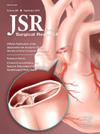The Hidden Toll: Demographic Changes in Suicide Attempts During the Coronavirus Disease-19 Era
IF 1.7
3区 医学
Q2 SURGERY
引用次数: 0
Abstract
Introduction
The coronavirus disease-19 (COVID-19) pandemic, characterized by social isolation and economic disparity, has impacted mental health in the United States. While prior studies have linked the pandemic to increased rates of intentional penetrating trauma, the impact of self-inflicted injuries has not been thoroughly examined. We hypothesize an increased national rate of suicide attempts post-COVID-19 compared to previous years and aim to investigate shifts in demographics of trauma patients attempting suicide.
Methods
The Trauma Quality Improvement Program database was divided into prepandemic (2017-2019) and pandemic years (2020-2022). Bivariate analyses were performed.
Results
From 73,967 patients, those presenting in the COVID era had a statistically decreased rate of suicide attempts (1.3% versus 1.4%, P < 0.001) compared to prepandemic. Most suicide attempts occurred with knives in both groups (pandemic 50.9% versus prepandemic 50.2%, P = 0.06), who also had similar injury severity scores (median, 8). However, pandemic suicide attempts more commonly occurred in Blacks (13.3% versus 11.9%, P < 0.001), Hispanics (13.4% versus 12.0%, P < 0.001), young adults (age 20-39 y) (51.8% versus 49.9%, P < 0.001), and individuals with mental health disorders (50.6% versus 48.2%, P < 0.001). The mortality rate remained similar between cohorts (pandemic 19.8% versus prepandemic 19.5%, P = 0.26).
Conclusions
The pandemic was associated with a similar rate of suicide attempts among trauma patients but has led to a shift in demographics. Specifically, increased suicide attempts among Blacks, Hispanics, young adults, and those with mental health disorders. This highlights the pandemic's secondary impact and reinforces the need for targeted preventative measures for these populations during periods of increased stress.
隐藏的代价:冠状病毒时代自杀企图的人口变化
以社会隔离和经济差距为特征的冠状病毒病-19 (COVID-19)大流行已经影响了美国人的心理健康。虽然先前的研究已将大流行与故意穿透性创伤发生率上升联系起来,但尚未彻底审查自我伤害的影响。我们假设与前几年相比,2019冠状病毒病后全国自杀未遂率有所增加,并旨在调查企图自杀的创伤患者的人口统计学变化。方法将创伤质量改善计划数据库分为流行前(2017-2019)和流行年(2020-2022)。进行双变量分析。结果在73,967例患者中,在COVID时代出现的患者自杀未遂率有统计学下降(1.3%对1.4%,P <;0.001),与大流行前相比。两组中大多数自杀企图都是用刀(大流行期50.9% vs大流行前50.2%,P = 0.06),他们也有相似的伤害严重程度评分(中位数,8)。然而,大流行自杀企图更常见于黑人(13.3%对11.9%,P <;0.001),西班牙裔(13.4%对12.0%,P <;0.001),年轻人(20-39岁)(51.8%对49.9%,P <;0.001)和有精神健康障碍的个体(50.6%对48.2%,P <;0.001)。队列之间的死亡率保持相似(大流行期19.8% vs大流行前19.5%,P = 0.26)。结论:流感大流行与创伤患者自杀未遂率相似,但导致了人口统计学的转变。具体来说,黑人、西班牙裔、年轻人和有精神健康障碍的人自杀企图增加。这突出了大流行的次要影响,并加强了在压力增加期间为这些人群采取有针对性预防措施的必要性。
本文章由计算机程序翻译,如有差异,请以英文原文为准。
求助全文
约1分钟内获得全文
求助全文
来源期刊
CiteScore
3.90
自引率
4.50%
发文量
627
审稿时长
138 days
期刊介绍:
The Journal of Surgical Research: Clinical and Laboratory Investigation publishes original articles concerned with clinical and laboratory investigations relevant to surgical practice and teaching. The journal emphasizes reports of clinical investigations or fundamental research bearing directly on surgical management that will be of general interest to a broad range of surgeons and surgical researchers. The articles presented need not have been the products of surgeons or of surgical laboratories.
The Journal of Surgical Research also features review articles and special articles relating to educational, research, or social issues of interest to the academic surgical community.

 求助内容:
求助内容: 应助结果提醒方式:
应助结果提醒方式:


